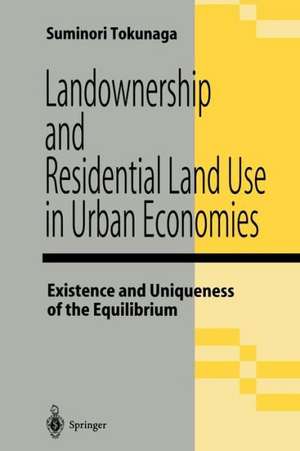Landownership and Residential Land Use in Urban Economies: Existence and Uniqueness of the Equilibrium
Autor Suminori Tokunagaen Limba Engleză Paperback – 12 feb 2012
Preț: 378.92 lei
Nou
Puncte Express: 568
Preț estimativ în valută:
72.52€ • 74.74$ • 61.23£
72.52€ • 74.74$ • 61.23£
Carte tipărită la comandă
Livrare economică 01-15 martie
Preluare comenzi: 021 569.72.76
Specificații
ISBN-13: 9784431684121
ISBN-10: 4431684123
Pagini: 136
Ilustrații: VII, 127 p.
Dimensiuni: 155 x 235 x 7 mm
Greutate: 0.2 kg
Ediția:Softcover reprint of the original 1st ed. 1996
Editura: Springer
Colecția Springer
Locul publicării:Tokyo, Japan
ISBN-10: 4431684123
Pagini: 136
Ilustrații: VII, 127 p.
Dimensiuni: 155 x 235 x 7 mm
Greutate: 0.2 kg
Ediția:Softcover reprint of the original 1st ed. 1996
Editura: Springer
Colecția Springer
Locul publicării:Tokyo, Japan
Public țintă
ResearchCuprins
1. Introduction.- 1.1. Objective of the book.- 1.2. Review of Related Research.- 1.3. Plan of the book.- 2. Behavior of the Household with Land.- 2.1. Introduction.- 2.2. Basic Model of the Household with Land.- 2.3. Characteristics of Maximum Utility.- 2.4. Characteristics of the Optimal Lot Size and the Autarkic Land Rent.- 2.5. Conclusion.- 3. Impact of ?-landownership on Residential Land Use Equilibria.- 3.1. Introduction.- 3.2. The ?-landownership Model.- 3.3. Definition of the Land Use Equilibrium.- 3.4. Existence and Uniqueness of the Land Use Equilibrium.- 3.5. Comparative Statics.- 3.6. Conclusion.- Appendix 3.A: Proof of Lemma 3.6.- Appendix 3.B: Proof of Proposition 3.2.- Appendix 3.C: Proof of relation (3.31).- Appendix 3.D: Formal derivation of results for case 1 in Section 3.5.2.- Appendix 3.E Formal derivation of results for case 2 in Section 3.5.2.- 4. Impact of S-landownership on Residential Land Use Equilibria.- 4.1. Introduction.- 4.2. The S-landownership Model.- 4.3. Existence and Uniqueness of the Equilibrium.- 4.4. Comparative Statics.- 4.5. Conclusion.- Appendix 4.A: Proof of relation (4.22).- Appendix 4.B: Proof of Proposition 4.2.- Appendix 4.C: Proof of relation (4.25).- 5. Landownership and Welfare Impacts of Zoning Regulations.- 5.1. Introduction.- 5.2. A Crowding Externalities Model without a Zoning Regulation.- 5.3. A Crowding Externalities Model with a Zoning Regulation.- 5.4. Impact of Minimum Lot Size Regulation on Residential Land Use Equilibria.- 5.5. Conclusion.- Appendix 5.A: Case of a Large MLS Regulation.- 6. Conclusion.- References.- Author index.














